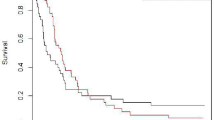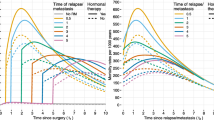Abstract
Evidence suggests that the increasing life expectancy levels at birth witnessed over the past centuries are associated with a decreasing concentration of the survival times. The purpose of this work is to study the relationships that exist between longevity and concentration measures for some regression models for the evolution of survival. In particular, we study a family of survival models that can be used to capture the observed trends in longevity and concentration over time. The parametric family of log-scale-location models is shown to allow for modeling different trends of expected value and concentration of survival times. An extension towards mixture models is also described in order to take into account scenarios where a fraction of the population experiences short term survival. Some results are also presented for such framework. The use of both the log-scale-location family and the mixture model is illustrated through an application to period life tables from the Human Mortality Database.






Similar content being viewed by others
References
Arias E (2010) United States life tables, 2006. National vital statistics reports, vol 58(21). National Center for Health Statistics, Hyattsville
Atkinson T (1970) On the measurement of inequality. J Econ Theory 2:244–263
Baudisch A (2011) The pace and shape of ageing. Methods Ecol Evol 2(4):375–382
Bhattacharya N, Mahalanobis B (1967) Regional disparities in household consumption in India. J Am Stat Assoc 62(317):143–161
Bonetti M, Gigliarano C, Muliere P (2009) The Gini concentration test for survival data. Lifetime Data Anal 15:493–518
Bongaarts J, Feeney G (2002) How long do we live? Popul Dev Rev 28(1):13–29
Booth H, Tickle L (2008) Mortality modelling and forecasting: a review of models. Ann Actuar Sci 3(I/II):3–43
Brown DC, Hayward MD, Montez JK, Humme RA, Chiu C, Hidajat MM (2012) The significance of education for mortality compression in the United States. Demography 49:819–840
Canudas-Romo V (2008) The modal age at death and the shifting mortality hypothesis. Demogr Res 19(30):1179–1204
Congdon P (2004) Modelling trends and inequality in small area mortality. J Appl Stat 31(6):603–622
Cox DR (1972) Regression models and life-tables (with discussion). J R Stat Soc Ser B 34:187–220
Debón A, Martínez-Ruiz F, Montes F (2012) Temporal evolution of mortality indicators: application to spanish data. N Am Actuar J 16(3):364–377
Finkelstein MS (2003) A model of aging and a shape of the observed force of mortality. Lifetime Data Anal 9:93–109
Fries JF (1980) Aging, natural death, and the compression of morbidity. N Engl J Med 303(3):130–135
Gastwirth JL (1971) A general definition of the Lorenz Curve. Econometrica 31:1037–1039
Gillespie DOS, Trotter MV, Tuljapurkar SD (2014) Divergence in age patterns of mortality change drives international divergence in lifespan inequality. Demography 51:1003–1017
Gini C (1912) Variabilità e mutabilità. Contributo allo studio delle distribuzioni e relazioni statistiche. Studi Economico-Giuridici dell’Università di Cagliari. III
Gini C (1914) Sulla misura della concentrazione e della variabilità dei caratteri. Atti R Ist Veneto Sci Lett Arti LXXIII(part 2):1203–1248
Haberman S, Renshaw A (2008) Mortality, longevity and experiments with the LeeCarter model. Lifetime Data Anal 14:286–315
Hanada K (1983) A formula of Gini’s concentration ratio and its applications to life tables. J Jpn Stat Soc 19:293–325
Human Mortality Database (2015) University of California, Berkeley (USA), and Max Planck Institute for Demographic Research (Germany). http://www.mortality.org
Johnson NL, Kotz S, Balakrishnan N (1995) Continuous univariate distributions, vol 2. Wiley, Hoboken
Kakwani NC (1980) Income inequality and poverty: methods of estimation and policy applications. Oxford University Press, Oxford
Kannisto V (2000) Measuring the compression of mortality. Demogr Res 3(6):1–24
Kannisto V (2001) Mode and dispersion of length of life. Population 13(1):159–172
Kendall M, Stuart A (1977) The advanced theory of statistics, vol I. Mac Millan Publishing, New York
Lawless JF (2003) Statistical models and methods for lifetime data. Wiley, New York
Lorenz MO (1905) Methods of measuring the concentration of wealth. Publ Am Stat Assoc 9(70):209–219
Michetti B, Dall’Aglio G (1957) La differenza semplice media. Statistica 7(2):159–255
Muliere P, Scarsini M (1989) A note on stochastic dominance and inequality measures. J Econ Theory 49:314–323
Nygard F, Sandröm A (1981) Measuring income inequality. Almqvist and Wilsell International, Stockholm
Oeppen J, Vaupel JW (2002) Broken limits to life expectancy. Science 296:1029–1031
Ostasiewicz K, Mazurek E (2013) Comparison of the Gini and Zenga indexes using some theoretical income distributions abstract. Oper Res Decis 1:37–62
Pietra G (1915) Delle relazioni tra gli indici di variabilità I, II. Atti R Ist Veneto Sci Lett Arti LXXIV(II):775–804
Shaked M, Shanthikumar JG (1994) Stochastic orders and their applications. Academic Press Inc, Boston
Shaked M, Shanthikumar JG (2007) Stochastic orders. Springer, New york
Shkolnikov VM, Andreev EE, Begun AZ (2003) Gini coefficient as a life table function: computation from discrete data, decomposition of differences and empirical examples. Demogr Res 8:305–358
United Nations, Department of Economic and Social Affairs, Population Division (2013) World population ageing. ST/ESA/SER.A/348
van Raalte AA, Martikainen P, Myrskylä M (2014) Lifespan variation by occupational class: compression or stagnation over time? Demography 51:73–95
Vaupel JW, Canudas-Romo V (2003) Decomposing change in life expectancy: a bouquet of formulas in honor of Nathan Keyfitz’s 90th birthday. Demography 40:201–216
Wilmoth JR, Horiuchi S (1999) Rectangularization revisited: variability in age at death within human populations. Demography 36(4):475–95
Wrycza TF, Baudisch A (2014) The pace of aging: intrinsic time scales in demography. Demogr Res 30(57):1571–1590
Author information
Authors and Affiliations
Corresponding author
Electronic supplementary material
Below is the link to the electronic supplementary material.
Rights and permissions
About this article
Cite this article
Gigliarano, C., Basellini, U. & Bonetti, M. Longevity and concentration in survival times: the log-scale-location family of failure time models. Lifetime Data Anal 23, 254–274 (2017). https://doi.org/10.1007/s10985-016-9356-1
Received:
Accepted:
Published:
Issue Date:
DOI: https://doi.org/10.1007/s10985-016-9356-1




